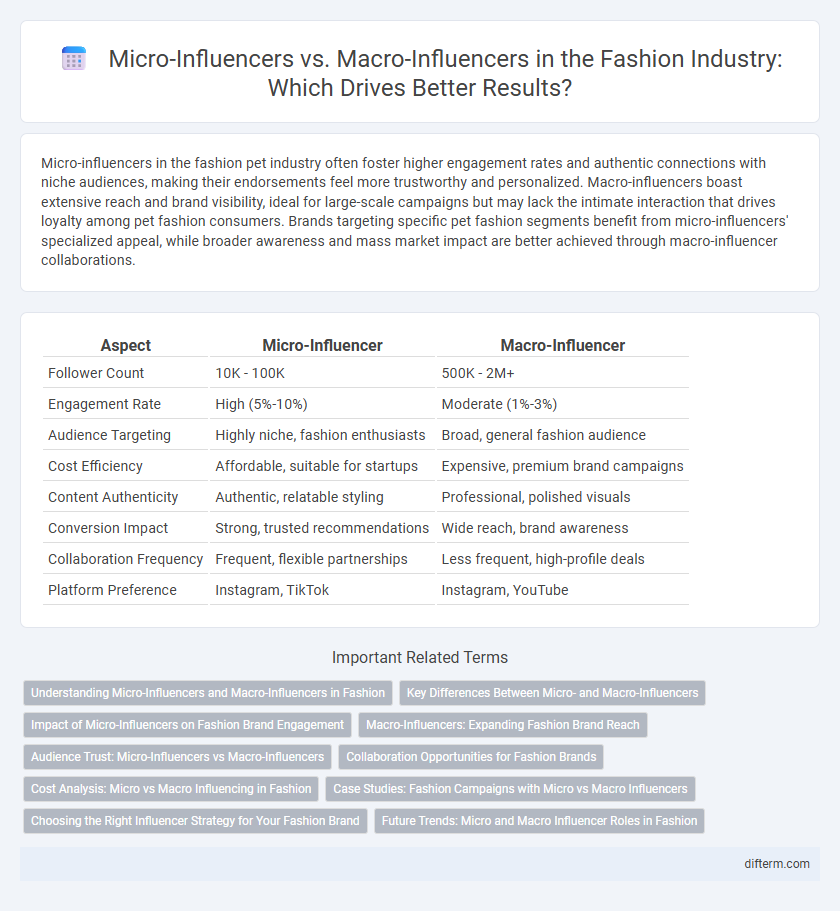Micro-influencers in the fashion pet industry often foster higher engagement rates and authentic connections with niche audiences, making their endorsements feel more trustworthy and personalized. Macro-influencers boast extensive reach and brand visibility, ideal for large-scale campaigns but may lack the intimate interaction that drives loyalty among pet fashion consumers. Brands targeting specific pet fashion segments benefit from micro-influencers' specialized appeal, while broader awareness and mass market impact are better achieved through macro-influencer collaborations.
Table of Comparison
| Aspect | Micro-Influencer | Macro-Influencer |
|---|---|---|
| Follower Count | 10K - 100K | 500K - 2M+ |
| Engagement Rate | High (5%-10%) | Moderate (1%-3%) |
| Audience Targeting | Highly niche, fashion enthusiasts | Broad, general fashion audience |
| Cost Efficiency | Affordable, suitable for startups | Expensive, premium brand campaigns |
| Content Authenticity | Authentic, relatable styling | Professional, polished visuals |
| Conversion Impact | Strong, trusted recommendations | Wide reach, brand awareness |
| Collaboration Frequency | Frequent, flexible partnerships | Less frequent, high-profile deals |
| Platform Preference | Instagram, TikTok | Instagram, YouTube |
Understanding Micro-Influencers and Macro-Influencers in Fashion
Micro-influencers in fashion boast highly engaged niche audiences, typically ranging from 10,000 to 100,000 followers, and drive authentic brand connections through personalized content. Macro-influencers exceed 100,000 followers and offer extensive reach, often collaborating with major fashion labels to amplify brand visibility on a mass scale. Choosing between micro and macro-influencers depends on campaign goals, targeting precision, and budget, with micro-influencers excelling in trust and macro-influencers in broad awareness.
Key Differences Between Micro- and Macro-Influencers
Micro-influencers in the fashion industry typically have between 10,000 to 100,000 followers and boast higher engagement rates due to their niche audiences and perceived authenticity. Macro-influencers range from 100,000 to millions of followers, offering broader reach but often lower engagement per follower compared to micro-influencers. Brands choosing between micro- and macro-influencers weigh factors like targeted audience engagement, budget constraints, and campaign objectives to maximize impact and ROI.
Impact of Micro-Influencers on Fashion Brand Engagement
Micro-influencers in the fashion industry generate higher engagement rates compared to macro-influencers, as their niche audiences exhibit greater trust and authenticity. Brands leveraging micro-influencers experience increased user interaction, with up to 60% more comments and likes on sponsored content due to closer community connections. Targeted campaigns with micro-influencers result in improved conversion rates and stronger brand loyalty, enhancing overall marketing ROI for fashion labels.
Macro-Influencers: Expanding Fashion Brand Reach
Macro-influencers in the fashion industry boast follower counts ranging from 100,000 to several million, offering vast audience exposure that significantly amplifies brand visibility. Their established credibility and broad demographic appeal enable fashion brands to drive engagement across diverse markets, making them ideal partners for large-scale campaigns. Collaborations with macro-influencers often result in higher brand awareness and increased sales due to their ability to influence purchasing decisions on a mass level.
Audience Trust: Micro-Influencers vs Macro-Influencers
Micro-influencers in the fashion industry typically command higher audience trust due to their perceived authenticity and closer, more personal engagement with followers. In contrast, macro-influencers, while boasting larger audiences and extensive reach, often face skepticism regarding the genuineness of their endorsements. Brands seeking authentic connections in fashion marketing increasingly favor micro-influencers for their ability to foster loyal, trust-driven communities.
Collaboration Opportunities for Fashion Brands
Micro-influencers in the fashion industry offer highly engaged niche audiences, making them ideal for authentic brand collaborations and targeted product launches. Macro-influencers provide extensive reach and mass visibility, enabling fashion brands to amplify campaigns and increase overall brand awareness quickly. Combining both types can optimize marketing strategies by balancing deep consumer connection with broad exposure.
Cost Analysis: Micro vs Macro Influencing in Fashion
Micro-influencers in the fashion industry offer cost-effective marketing solutions with average engagement rates of 3-5% and lower fees ranging from $100 to $1,000 per post, compared to macro-influencers who charge between $5,000 and $20,000 with engagement rates often below 2%. Brands targeting niche fashion audiences benefit from micro-influencers' authentic connections and higher ROI, making them ideal for startups and small labels. Macro-influencers, although more expensive, provide extensive reach across millions of followers, suitable for large fashion campaigns requiring mass visibility.
Case Studies: Fashion Campaigns with Micro vs Macro Influencers
Fashion campaigns leveraging micro-influencers demonstrate higher engagement rates due to their niche audiences, as seen in Glossier's targeted Instagram collaborations where micro-influencers increased product visibility by 50%. Conversely, macro-influencers in campaigns like Calvin Klein's global rollout delivered expansive reach, generating millions of impressions but with comparatively lower engagement per follower. Case studies reveal that micro-influencer campaigns foster authentic brand connections and drive conversions more effectively in highly segmented fashion markets.
Choosing the Right Influencer Strategy for Your Fashion Brand
Micro-influencers in fashion offer higher engagement rates and authentic connections with niche audiences, ideal for brands targeting specific style communities. Macro-influencers provide broad reach and mass brand awareness, suitable for launching new collections or expanding market presence. Selecting the right influencer strategy depends on your fashion brand's goals, budget, and desired audience impact.
Future Trends: Micro and Macro Influencer Roles in Fashion
Micro-influencers in the fashion industry are expected to drive hyper-targeted engagement and niche brand loyalty due to their authentic connections and high follower interaction rates. Macro-influencers will leverage expansive reach and cross-channel presence to shape broad market trends and global brand narratives. The future landscape emphasizes a hybrid strategy where brands integrate micro-influencers' credibility with macro-influencers' extensive visibility to maximize campaign effectiveness.
Micro-influencer vs Macro-influencer (fashion industry) Infographic

 difterm.com
difterm.com